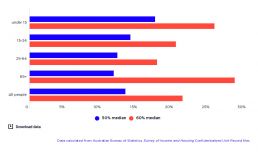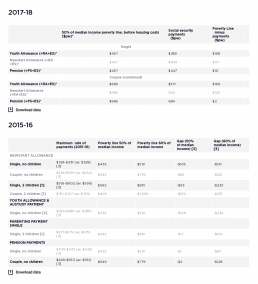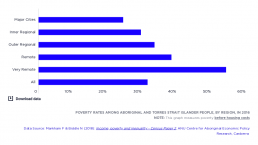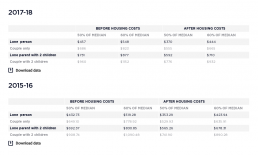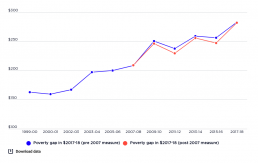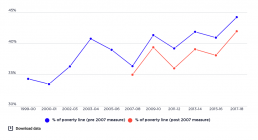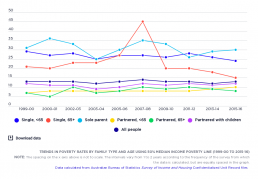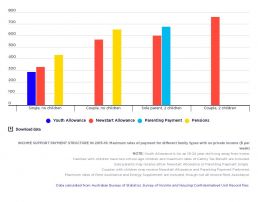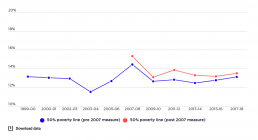Rate of poverty by age (% of people)
This graph displays the rate of poverty among all people by age groups. 2017-18: Among children, the rate of poverty is 17.7% based on the 50% of median income poverty line, and 25.5% when using the 60% poverty line. The poverty rate among young people (15-24 years) is also above average at 13.9% (20.2% when the 60% of median income poverty line is used). Among people aged 25 to 64 years, poverty rates are somewhat lower (at 12.1% and 17.6% at the 50% and 60% of median income poverty lines respectively). People 65 years and over who own or are buying their home are less likely to experience poverty than the rest of the population when the 50% poverty line is used (10.3%) but more likely when the 60% poverty line is used (23.7%). This figure also shows the profound impact of housing costs on poverty rates among older people by displaying the poverty rate among the 10% of older people who rent their homes, which is considerably higher than that of older people who own their homes, at…
Comparison of selected income support payments and poverty lines, 2015-16 and 2017-18
High levels of poverty among households reliant on income support payments are due in part to the level of these payments, which generally sits below the poverty line. A household reliant on income support payments usually needs extra income such as part-time earnings to avoid poverty. How much extra income is needed depends on the difference between the payments and the poverty line, and also on housing costs (which are taken into account in this research). This table compares the standard maximum rates of major income support payments with before-housing poverty lines in 2015-16 and 2017-18. In this case, the gaps between maximum payment rates and poverty lines are based on a cameo family type with no private income, so they do not take account of the private incomes and housing costs of families in the ABS income survey sample.
Poverty rates among Aboriginal and Torres Strait Islander people, by region, in 2016
This graph shows that the poverty rate for Aboriginal and Torres Strait Islander people is 31%, and that poverty amongst Aboriginal and Torres Strait Islander people is twice as high in very remote communities (54%) as in major cities (24%). However, it must be noted that accurate measurement of poverty is in these communities is hampered by non-declaration of income and the complexity of family structures and income-sharing arrangements, all of which likely result in under-estimation of poverty in Aboriginal and Torres Strait Islander communities.
Poverty Lines by family type
This shows relative poverty in Australia using poverty lines of 50% and 60% of national median household income. More information on the definitions of poverty and different ways of measuring poverty can be found on our poverty page and our FAQ page. It also shows the poverty lines before and after housing costs are taken into account. Housing costs vary considerably among households, depending on whether those households are owners, purchasers or tenants and what part of Australia those households live in. In order to take into account the varying costs of housing, a separate set of ‘after housing costs’ poverty lines is used. This set is created by removing housing costs from disposable income before calculating the median income. This is a measure of the income required to pay for essentials other than housing. 2017-18: The table shows that the poverty line in 2017-18 for a single adult based on disposable income with no allowance for housing costs (the ‘before housing costs’…
Number of people below the poverty line
This table shows the number and percentage of people who live below the 50% and 60% of median income poverty lines in 2015-16 and 2017-18. It also shows the ‘poverty gap’, a measure of the depth of poverty for those living below the poverty line (the average gap between the incomes of people in poverty and the poverty line). It is important to measure poverty gaps, because even if the rate of poverty is reduced, this could still leave many people living well below the poverty line. 2017-18 After taking account of housing costs, over one in eight people (13.6%) live below the 50% of median income poverty line. The poverty rate among children is much higher, over one in six children (17.7%). The poverty rate among young people (aged 15-24) is 13.9%. There are 3,239,000 people living in poverty in Australia. This figure includes 774,000 children and 424,800 young people. The ‘poverty gap’ is 42% of the poverty line, or $282 a week. That is, people below the poverty line have incomes…
Trends in the poverty gap
This graph shows the average poverty gap for all people living below the poverty line, in dollars per week. These figures are indexed for inflation and are expressed in constant 2017-18 values. They are not adjusted for household size, so the average poverty gaps are boosted by the bigger gaps for larger households. It shows that average poverty gaps increased after 2007.
Trends in the poverty gap as a percentage of poverty line, 1999-00 to 2017-18
This graph measures the poverty gap (the average gap between the household incomes of those in poverty and the poverty line) as a percentage of the poverty line. It shows that the average gap between the household incomes of those in poverty and the poverty line rose from 34.3% of the poverty line in 1999-00 to 40.8% in 2003, fell in the boom years to 36.3% in 2007-08, then rose in sawtooth fashion to 44.2% in 2017-18. Broadly speaking, this is the opposite pattern to the trends in poverty rates. This reflects the changing composition of households below the poverty line. For example, a growing number of older people fell below the poverty line during the boom years from 2003 to 2007, but (relative to others in poverty such as people on Newstart Allowance) their average incomes were not as far below the line. The 2009 pension increase lifted many older people above the poverty line, increasing the share of people below the line with much lower incomes.
Trends in poverty rates by family type and age
This graph compares trends in poverty according to family type and age, between 1999-00 – 2015-16. It shows that, over this period, poverty rates were consistently higher for single people and sole parents than for partnered families. It also shows that poverty rates for people aged 65 and more, and for sole parents, were more variable than for other family types. The main shifts over the period are a decline in poverty among single people aged 65 and over; and a rise in poverty among partnered people, no matter their age. Poverty rates for single people fluctuated considerably more than for partnered people, especially for single people aged 65 and over, in part reflective of the closeness of single pension rates to the 50% median income poverty line.
Comparison of income support payment rates and poverty lines
Government payments in Australia include income support payments for adults in low income households (divided into the higher pension payments such as Age Pension and lower allowance payments such as Newstart Allowance), Family Tax Benefits for children in low and middle-income families, and supplementary payments such as Rent Assistance for private tenants in low-income households. This graph illustrates the rate structure that applied in 2015-16.
Trends in poverty, all people, 1999-00 to 2017-18
This graph shows the poverty rates, after housing costs have been deducted, as a percentage of all people from 1999-00 to 2017-18. Whilst we focus on the consistent estimates based on the pre-2007 measure by the ABS (lower line), this graph also includes the higher poverty rates derived from the 2007-08 ABS income measure (upper line). The graph shows how the overall poverty rate fluctuated within a band between 11.5% and 14.5% between 1999-00 and 2017-18. Poverty declined substantially from 13.1% in 1999 to 11.5% in 2003, rose sharply during the boom years to 14.4% just before the Global Financial Crisis (GFC) in 2007, declined to 12.6% in 2009, and since then has risen modestly to 13.1% in 2017-18.
